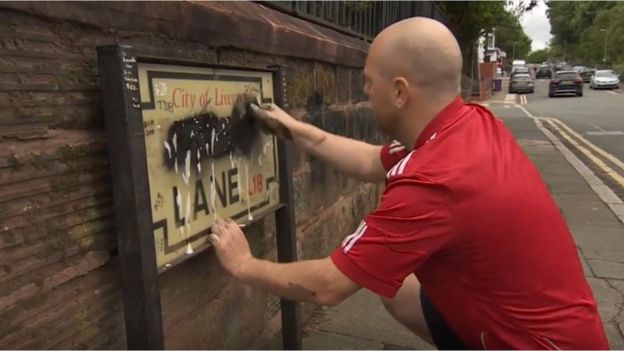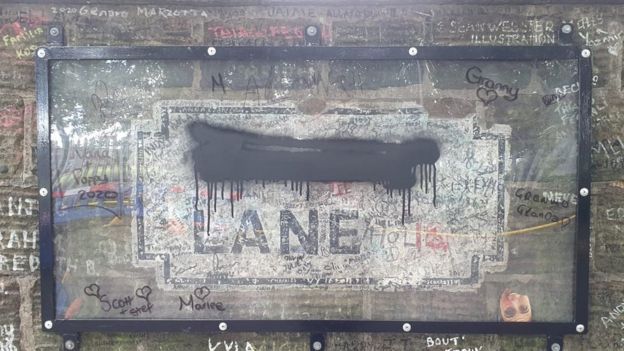Beatles News
Peter Jackson's upcoming documentary about the Beatles' troubled Get Back sessions has been postponed until next year.
The Beatles: Get Back, which chronicles the group's rehearsals and performances from January 1969 as it began work on a new album, won't premiere until August 2021. The movie was originally scheduled to open in September but has now been delayed for almost a year because of the coronavirus pandemic.
According to The Wrap, The Beatles: Get Back is just one of several projects that Disney has postponed until next year. The film expands on the Beatles' original 1970 movie Let It Be, which was envisioned as a TV special before the group changed direction during the making of the album.
The Beatles had intended to "get back" to their roots with a new stripped-down record following the studio experiments of albums like 1966's Revolver and Sgt. Pepper's Lonely Hearts Club Band from the next year, as well as the tumultuous and often fractured sessions of the White Album in 1968.
Source: ultimateclassicrock.com
Here’s your chance to celebrate Ringo Starr's 80th birthday with him virtually.
omaze.com is giving you the opportunity to win this amazing experience, and all you have to do is donate to charity. The more you donate, the more chances you have to win.
Every year, Ringo Starr asks for one simple birthday wish: peace and love. But this year, celebrations will be extra special because it’s his 80th birthday, plus you and a friend will join him on a private video call! You can chat about anything from music to meditation and how both can help us — especially now — while staying at home. Not only will you talk about meditation, you’ll also help provide healthcare workers on the front lines with Transcendental Meditation resources through the Heal the Healers Now initiative. And even though it’s Ringo’s birthday, he’s getting you an extra gift: a one-of-a-kind piece of art that he made himself! Don’t forget to wish him peace and love.
Source:
The Beatles’ classic ballad “Yesterday” has a dreamy and gentle melody, with lyrics that feel plucked out of a man’s deepest subconscious. So it’s only fitting that rock legend Paul McCartney came up with the earliest stages of the song in his sleep, then let them pour out of his soul on the piano next to his bed. Even better, that initial inspiration happened in the attic of the apartment where he lived with his then-girlfriend, who shaped so much of his music throughout the Beatles years.
“I woke up with a lovely tune in my head,” he told author Barry Miles for the biography Many Years From Now, which was published in 1998. “I thought, ‘That’s great, I wonder what that is?’ There was an upright piano next to me, to the right of the bed by the window. I got out of bed, sat at the piano, found G, found F sharp minor 7th – and that leads you through then to B to E minor, and finally back to E. It all leads forward logically. I liked the melody a lot but because I’d dreamed it I couldn’t believe I’d written it.”
Source: biography.com
The road signs on Penny Lane were attacked overnight on Thursday
Road signs on Penny Lane in Liverpool have been defaced over claims they are linked to slave merchant James Penny.
The markers had the word Penny blacked out and the word racist written above them on Thursday night.
The city's International Slavery Museum said it was not certain whether the street, which was immortalised in a song by The Beatles in 1967, was named after the 18th Century slave merchant.
A spokeswoman said "more research is needed" to clarify the name's origin.

City tour guide Jackie Spencer, who runs Blue Badge Tour Guides, said she was "absolutely livid".
"It's pure ignorance," she said.
"We've researched it and it has nothing to do with slavery. James Penny was a slave trader, but he had nothing to do with the Penny Lane area."
Local resident Emmett O'Neill, who has helped clean the paint from the signs, said he thought it was "an idiotic act".
"If you want something removed, there's ways and means," he said.
"Defacing Penny Lane signs isn't going to change a lot [and] it's the wrong way to go about things."
Several of the road's signs already had a large amount of graffiti on them, much of it Beatles-related, with one even bearing the signature of Sir Paul McCartney.

Liverpool City Council was criticised by historian Laurence Westgaph on Monday for "not doing enough" to acknowledge the city's links with slavery.
Mr Westgaph said he understood the actions, but added residents should "talk to the council and demand certain things that should have been changed years ago".
The city's mayor, Joe Anderson, said he was "frustrated" by the "defacement of our street signs".
"[It] does nothing to further advance the argument and the debate around Black Lives Matter here in Liverpool," he said.
"It isn't just about the artefacts and street names, it's also about how we change the fundamental things that are causing disadvantage and inequality within our city."

Who was James Penny?
- Liverpool merchant James Penny captained 11 voyages carrying slaves and had his own shipping company, James Penny & Co
- He was one of several Liverpool traders who spoke in favour of slavery at a parliamentary inquiry into the slave trade set up in 1788
- In evidence, he claimed slaves on his ships were allowed to play games, dance and sing and would "sleep better than the gentlemen do on shore"
- When Penny returned to Liverpool, the city's corporation, which was dominated by those with slaving interests, presented him with a silver-plated table centrepiece in gratitude
Source: International Slavery Museum
Source BBC Read more>>>
Sir Ringo Starr is the drummer in The Beatles, the biggest thing to ever come from Liverpool. The band made millions for their megahits in the UK and across the world. However, Sir Ringo has always been a little bit more mysterious than the other band members, especially with regards his name.
What is Sir Ringo Starr’s real name?
Sir Ringo Starr was, unsurprisingly to many, not born with that name.
Instead, he was born Richard Starkey, the only child of confectioners Richard Starkey and Elsie Gleave.
Like his bandmates, he is from Liverpool, though he was born in the Dingle area of the inner city.
Source: Jenny Desborough/express.co.uk
It was 56 years ago when Sergeant Pepper didn't teach the band to play, instead three of four Beatles landed in the early hours of a Darwin morning ahead of their imminent Australian Tour.
Key points:
Several hundred Beatles' fans gathered at Darwin airport in the early hours of the morning. Only a hand full of journalists had the opportunity to meet John, Paul, George and touring drummer Jimmie. The biggest band in the world was gracious, even after 30 hours of flights.
Ren Kelly, a Darwin-based disc jockey at a local commercial radio station and now Alice Springs' resident, heard rumours that the most popular band in the world at the time would be landing in the Northern Territory.
"I had a friend who was working as head of the tourist office up there, who had been talking with the Qantas staff … and he had tipped me off and said 'if I can get you an interview, would you like to?'" Mr Kelly said.
Source: abc.net.au
While the media loved pitting The Beatles against the Rolling Stones, the members of the two bands were very friendly with one another in the ’60s. If you attended the “happening” that was the orchestra recording session for “A Day in the Life” (1967), you’d have found Mick Jagger there.
During that same period, Stones founder Brian Jones contributed a saxophone part on the Beatles’ madcap B-side “You Know My Name (Look up the Number).” But the friendships dated back to long before the ’67 “Summer of Love.”
In 1963, as the Fab Four was rapidly gaining fame in the UK, the Stones were still hungry and largely unknown. So when Andrew Loog Oldham brought John Lennon and Paul McCartney to a Stones rehearsal, Jagger and his group accepted a song (“I Wanna Be Your Man”) the pair were offering.
Source: cheatsheet.com
The footage from the Let It Be sessions leaves no question as to the band’s gear choices during that time. George Harrison is often seen playing his custom-made rosewood Fender Telecaster (serial number 235594), which he later gave to Delaney Bramlett, and “Lucy,” the 1957 Gibson Les Paul Standard electric guitar (refinished to cherry red) given to him by Eric Clapton and famously seen in the Revolution promo film.
John Lennon is rarely seen without his stripped-down Epiphone Casino. Paul McCartney uses his 1963 Hofner 500/1 exclusively, although he can be seen playing his 1961 500/1 at Twickenham Film Studios (that model was stolen soon after filming - read on for the full story…), while his Rickenbacker 4001S was also present, but only as a backup.
Source: By Chris Corfield/guitarworld.com
Paul McCartney fiercely criticized the Italian live-music industry over its refund policy for his canceled 2020 concerts in a Facebook post that has apparently been deleted. McCartney was scheduled to perform in the Italian cities of Naples and Lucca this week but canceled the shows early last month due to the coronavirus pandemic.
In line with the policy of Assomusica, the official Italian promoters’ association, fans were offered vouchers but not refunds, prompting outrage online and a fiery statement from McCartney.
“It is outrageous that those who have paid for their tickets are not getting their money back. Without the fans there would be no live entertainment,” reads the statement, which was written in Italian and posted on McCartney’s official Facebook page before being deleted. “We strongly disagree with what the Italian government are doing. In every other country we were going to visit this summer the fans have all been offered full refunds. The organiser of our shows and the Italian law makers must do the right thing here. We are all extremely disappointed the shows could not take place and this is a real insult to the fans.”
Source: aol.com
When The Beatles parted ways in 1970, there was no shortage of bands vying to take the Fab Four’s place. Leading candidates included The Who, The Rolling Stones, and the upstart hard-rock outfit Led Zeppelin. And while Zep as a band was new, the group included a few old hands.
The list began with Jimmy Page, an ace session guitarist who’d played with both Stones and Who — and led the last stand of The Yardbirds. Page had brought in John Paul Jones, another familiar face on the London scene. Along with Robert Plant and John Bonham, Zep had its own version of a “fab four.”
For the remainder of the ’70s, Led Zeppelin enjoyed a level of commercial success that only The Beatles had tasted. But Page, who also served as Zep’s primary songwriter and record producer, never took the band’s success for granted.
Source: cheatsheet.com

